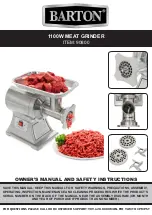
ENGLISH
58
EDGE GRINDING WITH GRINDING WHEELS
WARNING:
Wheels used for cutting
and edge grinding may break or kick
back if they bend or twist while the tool
is being used to do cut-off work or deep
grinding. To reduce the risk of serious
injury, limit the use of these wheels with
a standard Type 27 guard to shallow
cutting and notching [less than 13 mm
(1/2") in depth]. The open side of the
guard must be positioned away from
the operator. For deeper cutting with
a Type 1 cut-off wheel, use a closed
Type 1 guard.
1. Allow the tool to reach full speed before
touching the tool to the work surface.
2. Apply minimum pressure to the work surface,
allowing the tool to operate at high speed.
Grinding rate is greatest when the tool operates
at high speed.
3. Position yourself so that the open-underside of
the wheel is facing away from you.
4. Once a cut is begun and a notch is established
in the workpiece, do not change the angle of
the cut. Changing the angle will cause the wheel
to bend and may cause wheel breakage. Edge
grinding wheels are not designed to withstand
side pressures caused by bending.
5. Remove the tool from the work surface before
turning the tool off. Allow the tool to stop
rotating before laying it down.
WARNING:
Do not use edge grinding/
cutting wheels for surface grinding
applications because these wheels
are not designed for side pressures
encountered with surface grinding.
Wheel breakage and serious personal
injury may result.
Mounting Wire Brushes And Wire
Wheels (fi g. 1)
Wire cup brushes or wire wheels install directly on
the threaded spindle without the use of flanges.
Use only wire brushes or wheels provided with
M14 threaded hub. These accessories are available
at extra cost from your local dealer or authorised
service agent.
NOTE:
The type 27 guard is required when using
wire brushes or wheels.
CAUTION:
To reduce the risk of
personal injury wear work gloves when
handling wire brushes and wheels. They
can become sharp.
CAUTION:
To reduce the risk of
damage to the tool, wheel or brush
must not touch when mounted or while
use.
MOUNTING WIRE CUP BRUSH OR WHEEL
1. Place the tool on a table, guard up.
2. Thread the wheel or brush on the spindle by
hand.
3. Depress the spindle lock button (c) and use a
wrench on the hub of the wire wheel or brush to
tighten it.
4. To remove the brush or wheel, reverse the
above procedure.
NOTICE:
To reduce the risk of damage
to the tool seat the wheel hub before
turning the tool on.
Precautions To Take When
Sanding Paint
1. Sanding of lead based paint is NOT
RECOMMENDED due to the difficulty of
controlling the contaminated dust. The greatest
danger of lead poisoning is to children and
pregnant women.
2. Since it is difficult to identify whether or not a
paint contains lead without a chemical analysis,
we recommend the following precautions when
sanding any paint:
PERSONAL SAFETY
1. No children or pregnant women should enter
the work area where the paint sanding is
being done until all clean up is completed.
2. A dust mask or respirator should be worn by all
persons entering the work area. The filter should
be replaced daily or whenever the wearer has
difficulty breathing.
NOTE:
Only those dust masks suitable for
working with lead paint dust and fumes should
be used. Ordinary painting masks do not offer
this protection. See your local hardware dealer
for the proper N.I.O.S.H. approved mask.
3. NO EATING, DRINKING or SMOKING should
be done in the work area to prevent ingesting
contaminated paint particles. Workers should
wash and clean up BEFORE eating, drinking
or smoking. Articles of food, drink, or smoking
should not be left in the work area where dust
would settle on them.
ENVIRONMENTAL SAFETY
1. Paint should be removed in such a manner as
to minimize the amount of dust generated.
















































